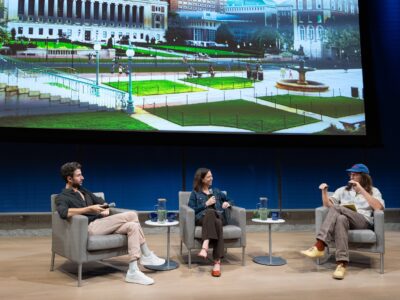Lamont’s founder, Maurice ‘Doc’ Ewing, had a vision for studying Earth’s past through sediments on the ocean floor. It came down to four words: “A core a day.” Wherever a Lamont research ship happened to be, Ewing or his scientists stopped at least once a day to extract a fresh column of mud, starting in the late 1940s. Ewing even invented a device, the Ewing Piston Corer, to make the work go easier. Due in part to Ewing’s foresight, the Lamont-Doherty Core Repository today houses the world’s largest collection of deep sea sediment cores—some 19,000 tubes of mud spanning 100 million years. Like pages in a book, the cores provide a record of Earth’s deep past.
Bill Ryan, a marine geophysicist, sailed on Lamont’s early ships—the R/V Vema and R/V Conrad–and recalls how smoothly the coring process became. “On the Conrad it was poetry,” he says, in the above video. In the 1970s, Ryan led a research cruise aboard the Glomar Challenger to the Mediterranean Sea, where he and his colleagues recovered sediments showing the Mediterranean had once nearly completely dried up. About 6 million years ago, as tectonic forces closed the Strait of Gibraltar, the sea slowly evaporated into a sheet of salt and other minerals.

Sediment cores have yielded other surprises. In a core recovered off Antarctica, Lamont scientist Jim Hays showed that the waxing and waning of Earth’s ice ages was controlled by variations in earth’s orbit around the sun, tilt, and orientation around its axis. In a 1976 study in Science, Hays and his colleagues proved to most of the scientific community that Milutin Milankovitch’s theory of climate change due to astronomical forces was correct. After the study’s publication, Hays’ Southern Ocean core became one of the most sought after in the repository. Today, bits of foam plug the holes where sediments have been gouged out for analysis.
The collection continues to grow. Lamont scientist Pratigya Polissar traveled to the central Pacific Ocean in 2012 aboard Lamont’s current research ship, the R/V Marcus Langseth, to collect sediments from the last 250,000 years. Polissar hopes to understand how the cyclic climate pattern, El Niño, changed in the past and how it may change in the future as climate continues to warm.
In the above video, Core Repository director Maureen Raymo provides an overview of the lab; Curator Nichole Anest and technician Angel Mojarro, pictured.



